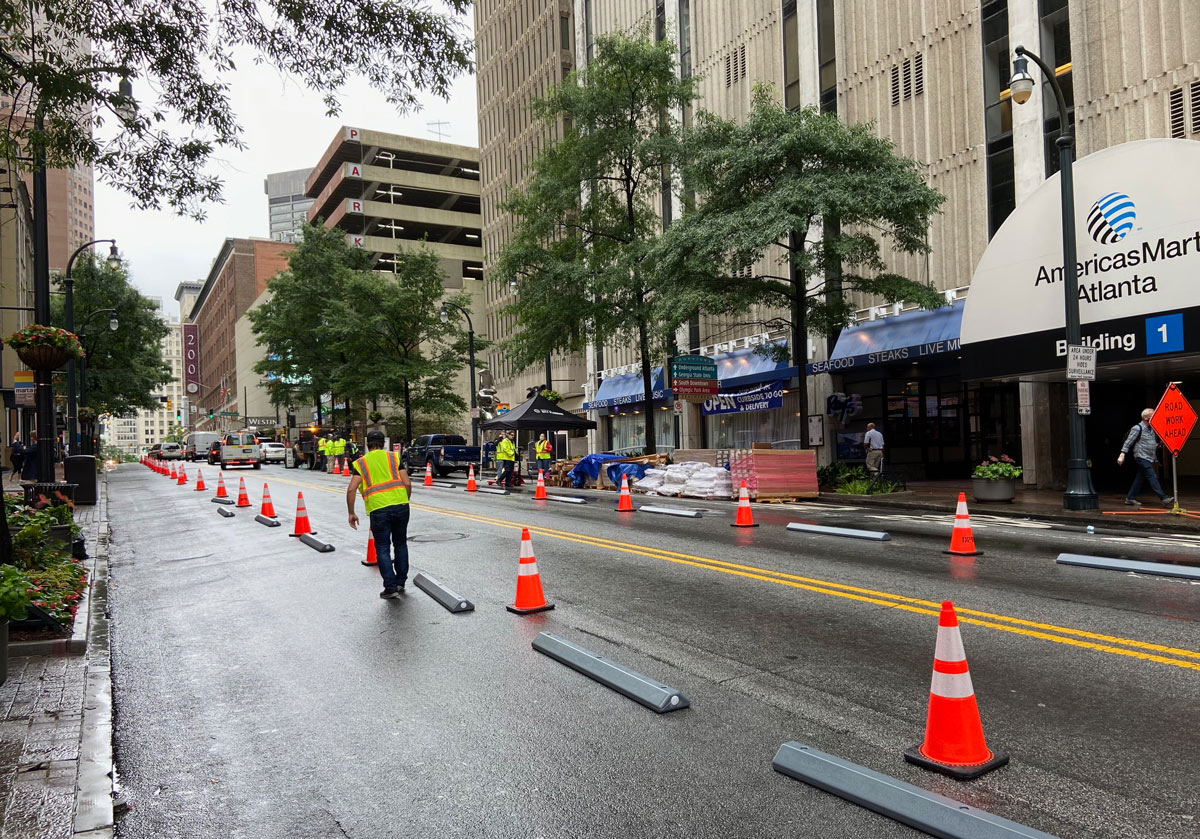
Photograph by Thomas Wheatley
A short stretch of downtown’s Peachtree Street is going on a diet—the kind of diet that slims down the notoriously car-choked corridor from four lanes to just two, freeing up space to provide pedestrians some much-needed breathing room.
Phase 1 of the city planning department’s three-part endeavor, which launched on Monday, is bringing physical barriers—planters, wheel stops, and flex posts—between the two center lanes and the newly created pedestrian spaces flanking them on either side. The finished product, which could be realized in a year or two, would resemble a Dutch-style woonerf—a vibrant space shared equally among pedestrians, cyclists, and motorists.
Whether the full plan comes to fruition, however, depends entirely on how the “Shared Street” demonstration affects traffic patterns, local businesses, and the overall safety of the thoroughfare dissecting downtown between Baker and Ellis streets.

Photograph by Thomas Wheatley

Photograph by Thomas Wheatley
Historically, Atlanta’s design has catered to motorists at the expense of pedestrian and cyclist safety, says Tim Keane, the city’s planning commissioner. As Atlanta’s population swells, this project represents an increased focus on people who use alternative modes of transportation, such as walking, biking, and using mass transit.
The three-block leg of Peachtree Street, Keane says, was selected for transformation because it’s at the heart of the city in an area where “there is not a tremendous amount of urban activity.” He means that, while there are abundant businesses in the area—including Peachtree Center’s Hub, AmericasMart, a smattering of hotels and restaurants, and coincidentally, this magazine’s office—few of them truly engage the community at the street level.

Photograph by Thomas Wheatley
The goal, Keane says, is “to find out how many new opportunities this will create on those few blocks.” Imagine, for instance, grabbing a bite from a Peachtree Center kiosk and enjoying it under the shade of downtown skyscrapers or (gasp!) being able to bike through downtown without worrying you might end up beneath a speeding pickup truck.
Darin Givens, co-founder of urbanist blog ThreadATL, says the shared street project will send “a really important message” to motorists: “These streets are not all about you and your needs.” In an ideal world, he adds, “We will have many of these shared spaces all over the city. The more it happens, the further we’ll get from people expecting streets to be all about car flow.”
Most of the stakeholders the city engaged during the planning process have voiced support—or at least a cautious optimism—for the pilot project, Keane says. Sure, some drivers might find the changes inconvenient, “But maybe motorists who want to fly through will just have to change their route.” The others can instead slow down and stay aware of their surroundings.
Phase 1 is expected to last 90 days, after which the city plans to paint the new pedestrian space and add seating. Based on how that goes, officials will architect the vision for a permanent shared space and begin brainstorming where the next one could go.
“This type of street revisioning isn’t appropriate for every street, but it’s right for many, many streets,” says Atlanta City Councilman Amir Farokhi, whose district includes this part of Peachtree Street. “I think our ambition shouldn’t just be that no one gets killed on city streets, but that everyone, regardless of their mode of transport, feels comfortable on our streets.”
Givens says Edgewood Avenue—specifically, the bar strip between the Beltline’s Eastside Trail and I-85—would be a fine place to carry on such efforts. (City transportation officials recently started blocking off the most high-traffic piece of Edgewood to combat a rash of street racing and stunt driving.) That’s not a bad idea, Farokhi says, adding that other congested roads in places like downtown, Midtown, Old Fourth Ward, and Little Five Points could benefit from road diets, too.
Initiatives to improve the lives of non-drivers are few and far between in Atlanta and are often met with pushback. The Peachtree Street project, Farokhi says, “is a sign that we’re more comfortable dipping our toes in the water, but I hope we shed our historic timidity in this space.”










![The North Carolina Museum of Natural Sciences’ newest exhibit is a [pre]historic first](https://cdn2.atlantamagazine.com/wp-content/uploads/sites/4/2024/04/DD-3-100x70.jpg)


